It is impossible to consider the history of development of something or anyone in isolation from the environment that surrounds it. So today I suggest you talk about what kind of world surrounded our ancestors.
Immediately suggest that we limit our story to a spatio-temporal framework. Since we live in the northern part of Eurasia, this territory is the closest to us, and therefore let's limit it. In Northern Eurasia, the first representatives of Homo sapiens appeared about 50 thousand years ago. Thus, it is logical to limit ourselves to these time frames in our story. This is the time of the so-called "last ice age". The latter he named for the reason that during the Pleistocene there have been repeated changes of cold and warm ages. In cold epochs, especially in the northern hemisphere, the development of cover glaciations, the decline in the level of the world's oceans, the climate in such epochs was much more severe than the current one. In warm intervals of the "interglacial" ice caps decreased, the level of the world ocean rose (sometimes even higher than in modern times), the climate was mild and warm.
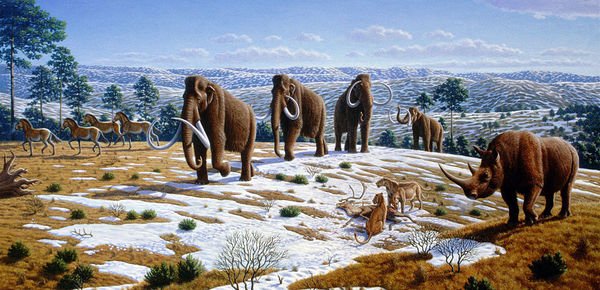
In Figure 1: Pleistocene landscape.
The last glacial epoch began about 110 thousand years ago. And finished about 10-9.5 thousand hp, to replace it came the modern interglacial, called Holocene. Thus, most of the time of human existence in Northern Eurasia falls precisely on the glacial period. So, what was the nature of Northern Eurasia in the Ice Age?
To begin, perhaps, follows from the climate that formed the natural environment. The climate in the ice age was cold, severe and sharply continental. In the north of Europe and in some areas of the north of present-day Russia extensive glacial glaciations formed, covering the whole space (Figure 2). In the mountains of the Urals, the Caucasus, Southern and Eastern Siberia, glaciations were mountain-valley, that is, they arose only in the mountains and foothill valleys. As a result of the formation of glaciers, which collected moisture from the atmosphere, very little snow fell out during the winter season, which led to the development of a zone of continuous "permafrost" that was encountered even in the north of present-day Kazakhstan. In addition, glaciations contributed to very strong winds, which carried sand and dust for many hundreds of kilometers, forming in some places the real dunes and manes.
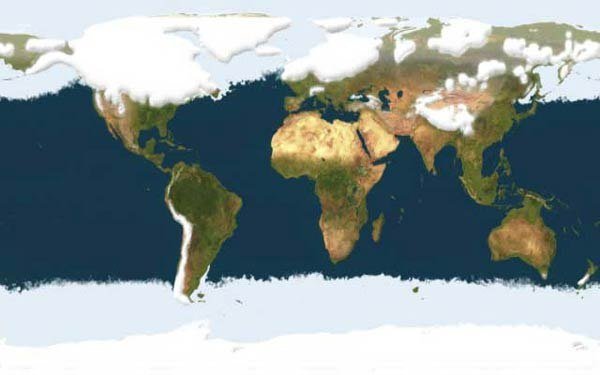
In Figure 2: Map of planet Earth in the last glacial period (from the Internet).
In such a harsh environment, under the influence of strong wind on the frozen ground could not climb trees, so the forest area decreased. Forest huddled mostly in floodplains, depressions, and on the mountain slopes. The vast space occupied by the dry grassy plains, known as tundra. These unique landscapes have no direct modern counterparts, they combined the features of the present tundra, steppe and forest steppe. Due to the abundant sunlight that is not absorbed by the forest cover, tundra get enough solar energy for growth. Thawing permafrost in the summer gave water for herbaceous plants. Thus, during the warm period was formed enough grass to feed thousands of herds of ungulates not only in summer but also during the cold season. In autumn the grass dries up and becomes "hay on the vine." As such, the grass remained standing until the following spring, and a small amount of snow falls it easily allows the animal to produce, even in winter.
Animals living in the tundra and adapted to these harsh conditions, we formed a specific community, called "mammoth fauna" (the so-called group of mammals living in the territory of Northern Eurasia in the Late Pleistocene) (Figure 3).
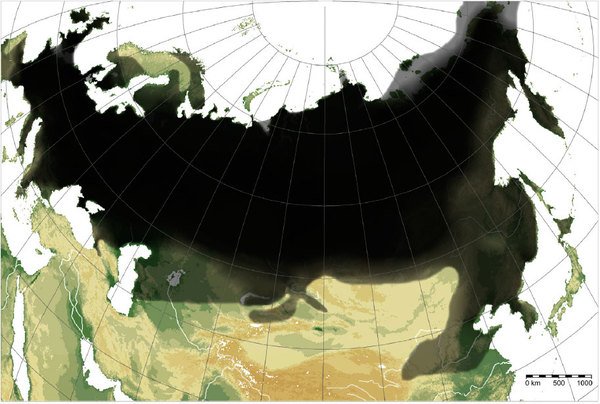
In Figure 3: Maximum distribution of mammoth fauna of Northern Eurasia in the Late Pleistocene (according to Kahlke, 2014)
The whole composition of the mammoth fauna can be divided into two large groups: consumers of plant biomass are herbivorous; Consumers of animal biomass - carnivores or predators. Each of the groups in turn was divided into smaller groups. So, among the herbivores there were those who ate only grass (saigas, horses, rhinoceroses, musk oxen, reindeer), those who consumed both grass and tree-shrub feeds (mammoths, bison, noble and giant deer), And someone preferred to feed on foliage and branches of bushes and trees (roe deer, elk, beavers). Predators also differed in variety. Small, like foxes and arctic foxes, fed on small rodents. The wolf and the wolverine mostly hunted medium-sized animals such as roe deer, reindeer and saiga. Of course, the main predator of the time was the cave lion, who hunted all the large animals, except perhaps for an adult mammoth and a woolly rhinoceros. No less, and perhaps even more dangerous predator were cave hyenas, which not only could successfully hunt large ungulates, but also actively consumed carrion. Moreover, their powerful jaws were so strong that they could bite the bones of the largest representatives of the mammoth fauna, mammoth and woolly rhinoceros. This is confirmed by a large number of gnawed remains of these animals in the cave lairs of hyenas.
Here is only the most generalized list of animals of mammoth fauna. Naturally, it was much more diverse, so in the foothills often met mountain goats and sheep, and with them red wolves and snow leopards. Himalayan bears lived in the Far East, gazelles in Mongolia and Transbaikalia, and gazelles in Central Asia. However, the most important feature of the whole mammoth fauna was the widespread distribution of such animals as mammoth, woolly rhinoceros, bison, horse, reindeer, saiga, musk ox, cave lion and cave hyena (Exhibit 4).
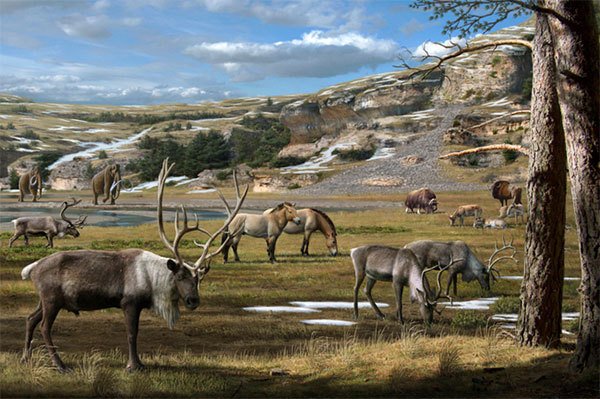
In Figure 4: Animals of mammoth fauna graze in the tundra steppe. Picture of Anton Maurizso.
Separately, I would like to note the similarity of the mammoth fauna with the fauna of the modern African savannah. So, both there and there one could meet elephants and rhinos, horses, various antelopes, and large bulls. Even such seemingly exotic predators as hyenas and lions, and they felt great in the conditions of the ice age. Environmental analogues (with a certain degree of conventionality) of African savannah animals were common on all continents (except Antarctica). So what is the reason for such an amazing similarity? It's very simple, all these faunas formed on similar landscapes - namely, in the conditions of vast plains overgrown with a lot of grass. These grassy plains formed excellent pastures that were able to feed huge herds of herbivores, and those in turn predators. Both of them actively fertilized the soil with their bodies and excrement. In the glacial period, such pastures existed on all continents, except for Antarctica of course. Therefore, the fauna inhabiting these pastures on all continents were similar in ecological terms.
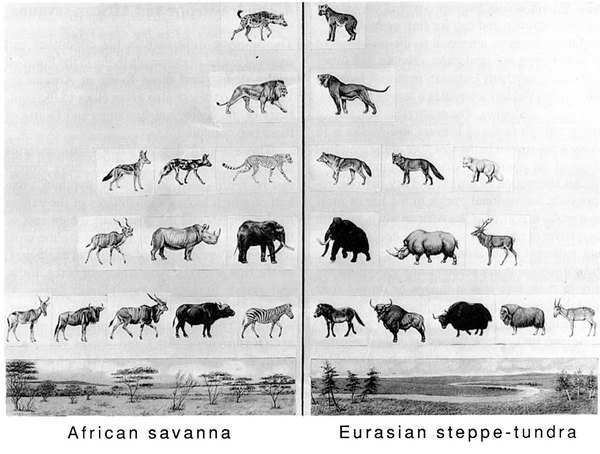
In Figure 5: the scheme for comparing the fauna of the African savannah and the Pleistocene tundra-steppe (according to Vereshchagin, Baryshnikov, 1982).
It is not surprising that our ancestors easily adapted to new conditions on all continents, wherever they would fall. After all, the most important thing, namely commercial animals, were similar to those to which they are accustomed for millions of years of life in Africa. Apparently, this helped our distant ancestors successfully settle all over the planet.